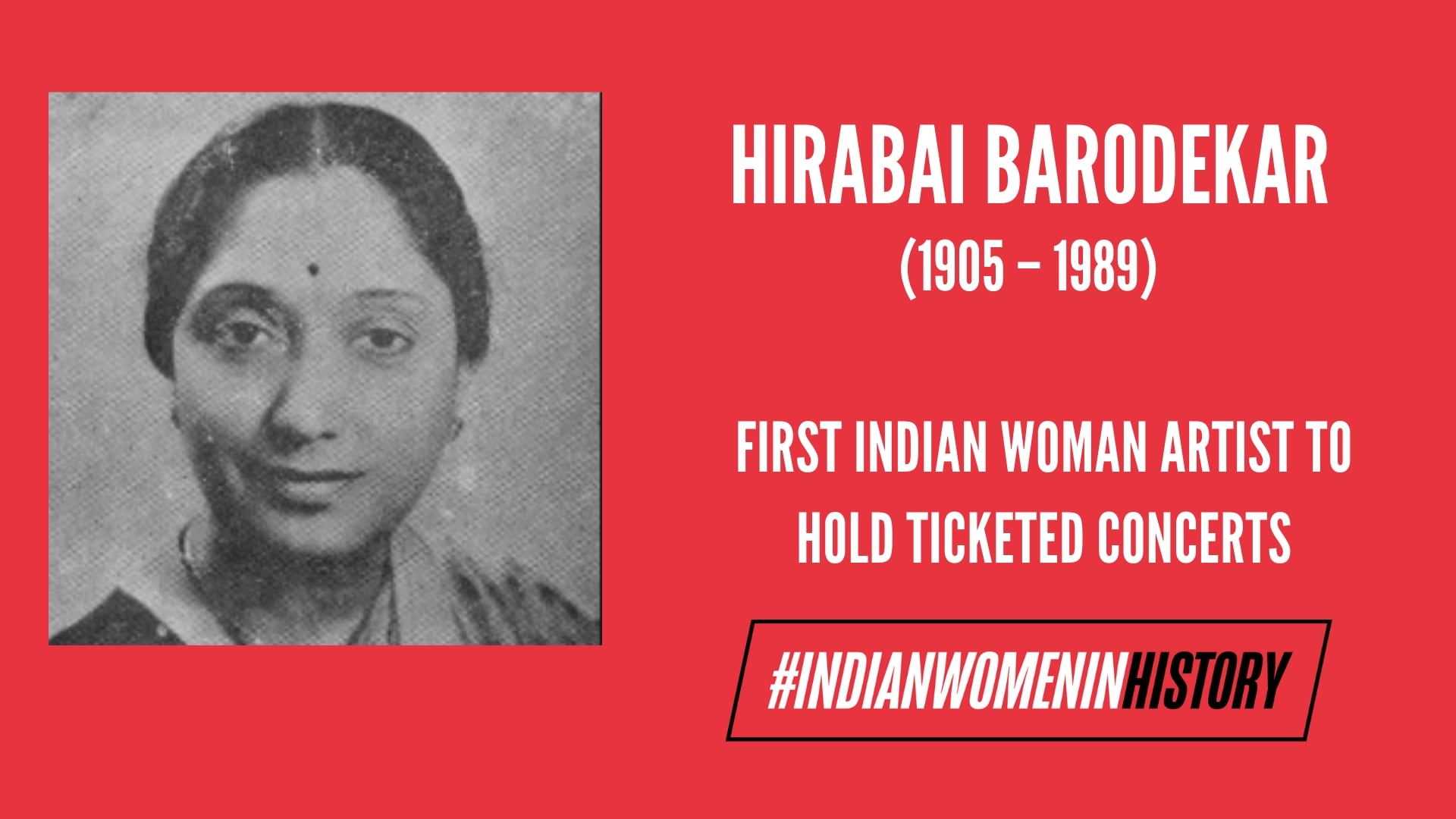This article is a part of the #IndianWomenInHistory campaign for Women’s History Month to remember the untold legacies of women who shaped India, especially India’s various feminist movements. One Indian woman is profiled each day for the whole of March 2019.
Born into a family steeped in music, Hirabai Barodekar followed in her parents’ footsteps and adopted music as her profession. At the pinnacle of her career, she was acclaimed as one of India’s leading vocalists. Even today she is venerated by aficionados and connoisseurs of Hindustani classical music.
Early Life
She was born in Miraj (Maharashtra) on 29th May 1905 as Champakali, the second child of Ustad Abdul Karim Khan founder of the renowned Kirana
In the course of time, they had five children – two sons and three daughters – all of whom became talented musicians in their adult lives. Hirabai’s parents separated in 1922 while she was still a teenager. Since the children went with the mother they adopted her maiden name Mane. Khan Saheb’s impact on his children’s singing style was thus very limited. In spite of the family turmoil. the siblings went ahead undaunted and managed to carve out successful music careers.
Career Kickstarts
Ahmed Khan, an exponent of the Agra
She created a record of sorts by staging the first ever ticketed (paid) public concert.
Her first break came in 1921 when the legendary vocalist Vishnu Digambar Paluskar, invited her to perform at the anniversary celebrations of Gandharva Mahavidyalaya, Bombay. Her debut at a national level festival came in 1937 at the All-India Music Conference, in Calcutta. Interestingly, a singing sensation of that era, Kesarbai Kerkar (a former disciple of Abdul Karim Khan) hustled Hirabai to Calcutta and introduced her before a mammoth gathering. The ‘who’s who’ among the audience was spellbound. They had no inkling that the shy and frail looking lady had so much talent! Since then there was no looking back for her.
The early 20th century was an age of transition and women’s emancipation. Though women had begun stepping out of their homes, the idea of an Indian woman performing onstage was frowned upon. Thus she successfully broke a barrier imposed on women. She created a record of sorts by staging the first-ever ticketed (paid) public concert. This unprecedented step helped to popularise Hindustani classical music, not only among discerning audience but also the general public who
In course of her training, Hirabai became multi-faceted, gaining mastery over diverse forms like
The landmark of her career came when she was invited to sing the national song Vande Mataram at the euphoric independence day celebrations held in Red Fort on the midnight of 15th of August 1947
In 1942, following the merger of Odeon with Columbia, many of these songs were repackaged under Columbia label. Among these figures, ‘Nandalala Naachre’, ‘Upavani Gaat
Also read: Gauhar Jaan: The Forgotten Doyen Of Hindustani Music | #IndianWomenInHistory
In 1968, Hirabai and her youngest sister Saraswati Rane recorded a duet based on Chandrakauns and Basant Bahar. In 1984, an audio-tape containing Marathi songs sung by Karim Khan and Hirabai Barodekar was released.
Personal Life
In 1924 Hirabai married Manikchand Gandhi who hailed from Solapur. They were blessed with a son. The family settled down in Pune. The couple had the onerous task of looking after a huge number of dependants economically. Therefore, struggles, obstacles, and problems continued to dog the singer’s personal life.
Movies And Music School
As a schoolgirl, Hirabai had actively participated in plays. Later she had abundant stager exposure. Quite naturally she wanted to explore the tinsel world. And she did just that. Her performances in films like
Glorious Moments
The landmark of her career came when she was invited to sing the national song Vande Mataram at the euphoric independence day celebrations held in Red Fort on the midnight of 15th of August 1947. In 1953, she was part of a prestigious delegation which visited China and several East African countries. The troupe successfully showcased India’s cultural heritage before a global audience.
Awards And Accolades
Her versatility earned her the sobriquet ‘Gaan Hira’ (a sparkling gem in the musical arena). Compliments and adulations poured in. The then Jagad guru Shankaracharya bestowed upon her the title
Last Years
Her brother-turned-Guru Suresh babu’s demise in 1952 gave a severe jolt to Hirabai. Years later, having bid adieu to stage performances Hirabai went on to live with her son and his family in their modest Pune residence aptly named “Swar Vilas”. She continued to impart music tuitions at home. There was always a steady footfall of musicians an music lovers at her home. She quietly passed away on
The Undying Flame
In 1998, several numbers sung by her were released on audio-tapes and CD under the caption ‘Classic Gold’ series. She left behind a band of talented vocalists including Prabha Atre, Malati Pande, Shaila Pandit, Janaki Iyer, Sarojini Sahotre, to name a few. Every year a grand music festival, Sureshbabu-Hirabai Smruti Sangeet Samaroh’ is held in Mumbai under the aegis of her leading disciple Dr. Prabha Atre. Since its inception way back in 1992, it has emerged as one of India’s prominent music festivals.
Also read: Annapurna Devi: The Enigmatic Genius of Hindustani Classical Music | #IndianWomeninHistory
References
1.
2. The Hindu
3. I Love India
4. World Library
About the author(s)
Delhi based Ruchira Ghosh is a trained journalist with nearly two & a half decade’s writing experience and exposure to print, web and television.




